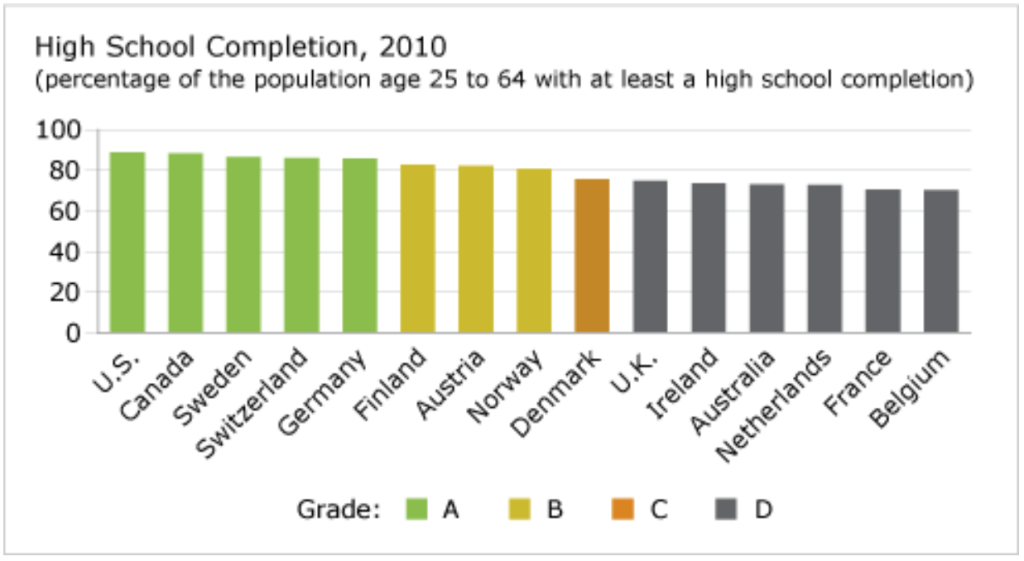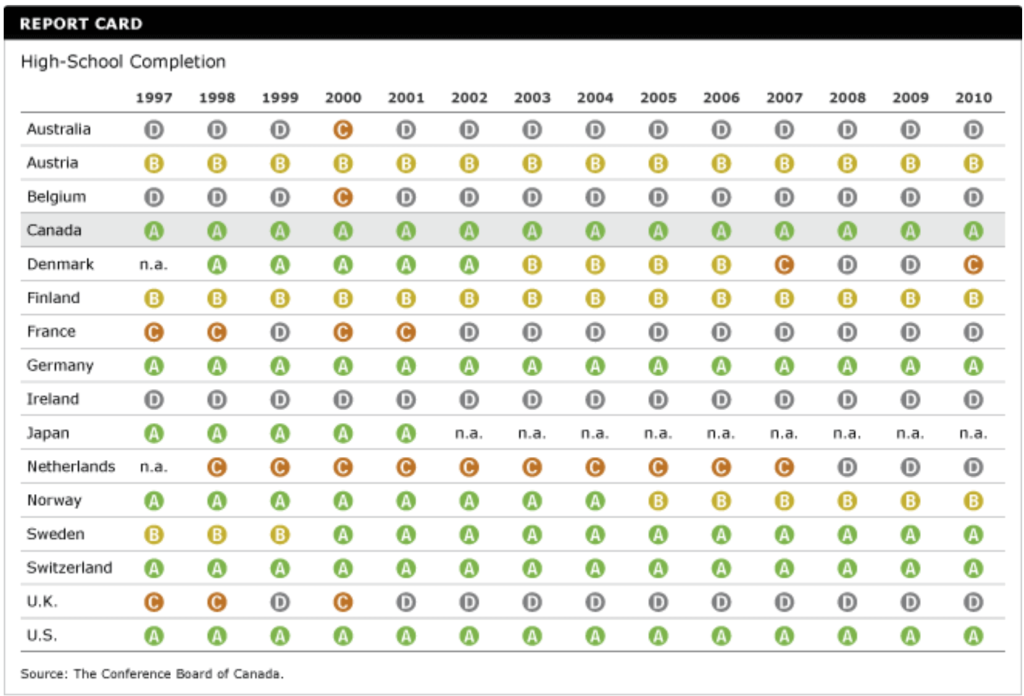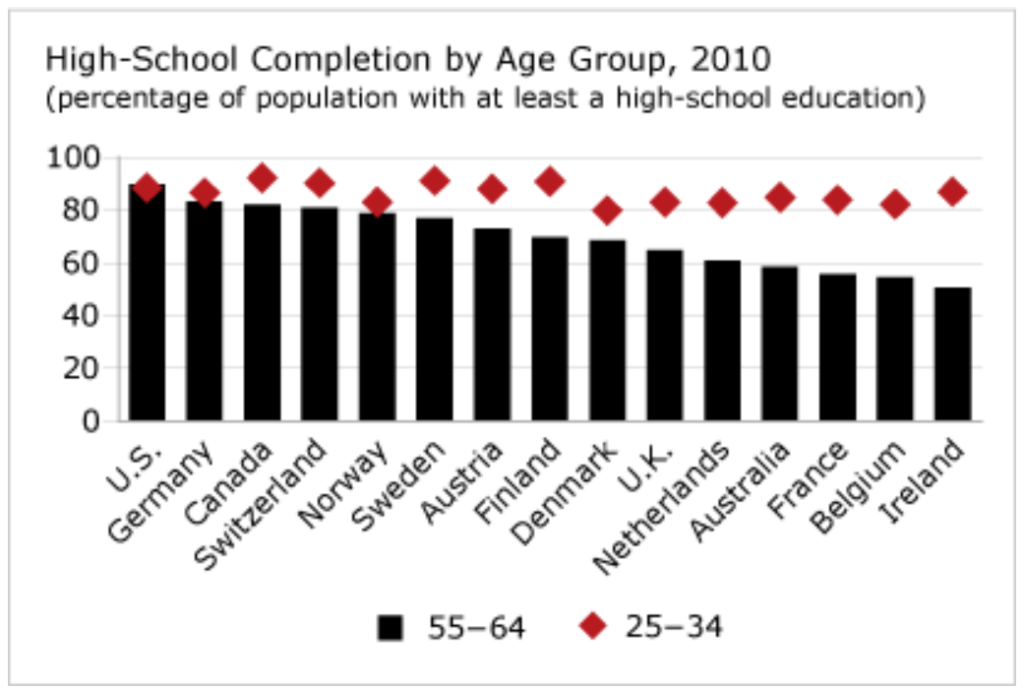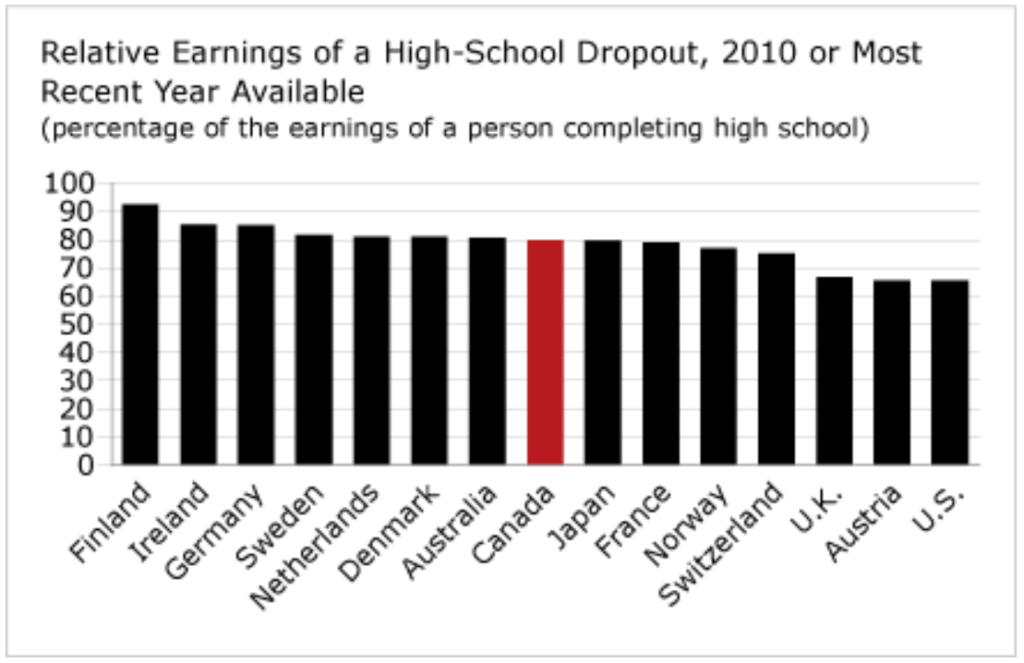High-School Completion
Key Messages
- Canada earns an “A” for its high-school completion rate and ranks 2nd out of 16 peer countries.
- Eighty-eight per cent of working-age Canadians have graduated from high school.
- Further improving Canada’s high-school completion rate is key to ensuring that most citizens have the basic skills to participate actively in society.

Putting Canada’s high-school completion rate in context
There is a growing consensus that high-school completion is the prerequisite stepping stone to post-secondary education, now deemed essential to success in the labour market. Governments have plenty of evidence that well-educated citizens are more actively engaged in society: they tend to make better choices about factors that affect their quality of life (e.g., diet, smoking, exercise); and they earn higher incomes than those who are less educated. Less prominent in the mind of the public, but equally well-known among decision-makers, is the fact that well-educated and skilled people make important contributions to business innovation, productivity, and national economic performance. In an interconnected global economy, countries with more highly skilled workers have a distinct competitive advantage.
How does Canada’s high-school completion rate compare to that of its peer countries?
Canada’s recent performance on its high-school completion rate compares very favourably to its peer countries. Canada is second only to the U.S. in the high-school completion rate of its working-age population.
How has Canada’s high-school completion rate ranked over time?
Between 1997 and 2010, Canada increased its high-school completion rate by nearly 11 percentage points (from 77.7 per cent to 88.4 per cent), maintaining an “A” throughout. Canadians have made high-school completion a priority. This accomplishment is driven less by official policy than by labour force entry-level requirements, social expectations (parents not wanting their children “left behind”), and overall prosperity (which reduces the need for early labour force entry). The education system has certainly encouraged “stay in school” programs, but broader economic and social factors have been more important than policy in contributing to Canada’s impressive performance on this indicator.

Which countries have made the most progress?
Ireland has made the most progress, with a 24 percentage point increase in its high-school completion rate between 1997 and 2010 (from 49.6 per cent to 73.5 per cent).
Despite this huge progress, Ireland still ranks relatively low, in 11th place, with a “D” grade. That’s because its average completion rate is being dragged down by the low completion rates for people aged 55 to 64. If Ireland were ranked on the high-school completion of its younger cohort—25 to 34 year olds—Ireland would come in 7th and receive an “A.” Over 96 per cent of those aged 25 to 34 in Ireland have completed high school, while only 50 per cent of 55 to 64 year olds have.
How do different age groups rank on high-school completion?
In general, younger age groups have a higher completion rate. If the peer countries were ranked on the share of people aged 25 to 34 years, Canada would jump from 2nd to 1st place, while the U.S. would drop from 1st place to 5th place.
The U.S. is the only peer country where the high-school completion rate of the older cohort (age 55 to 64) is higher than that of the younger cohort—but that’s partly because it has had a relatively high level of education for a longer time, and so there’s less room for improvement, similar to countries like Germany and Norway. An exception is Canada, which had the third highest completion rate in 2010 among its older population, yet still succeeded in improving the completion rate of its younger population.

What is the earnings benefit of completing high school?
People who do not graduate from high school earn substantially less than those who do graduate. A person without a high-school diploma in Canada earns 80 per cent of what a person with a diploma earns. The outlook for a dropout is even bleaker in the U.S., where someone without a diploma earns only 65 per cent of what a person who completed high school earns.

Is a high-school diploma still good enough?
Although Canadian high-school graduates do well financially, recent graduates who enter the labour force directly are not faring as well. In previous generations, a high-school diploma was adequate for most jobs, including many well-paid jobs. The growing complexity of work in the global knowledge economy and the rising rates of post-secondary completion in Canada, however, have reduced the relative value of a high-school diploma. Many employers now specify post-secondary education as a minimum qualification for employment, even if a degree or college diploma exceeds the actual skills requirements of their entry-level jobs.
What skills to students need to successfully made the transition to work?
The Conference Board developed an employability skills profile that outlines the skills, attitudes, and behaviours that individuals need to participate and progress in today’s dynamic world of work. Understanding and applying these skills will help individuals to enter, stay in, and progress in the world of work.
The Conference Board also developed an employability skills toolkit—a suite of practical tools to help individuals identify and reflect on their skills, plan skills development activities, implement development plans and practice their skills, and document and market their skills for best success.
Interested in accessing these documents?
- Employability Skills 2000+, Ottawa: The Conference Board of Canada.
- Employability Skills Toolkit, Ottawa: The Conference Board of Canada.

